New Equipment Reports: Snell Type I speaker; General Sound Micron III speaker; Avid 232 speaker; Koss 210/Kossfire speaker; Jensen System 500 speaker; BML Tracer 120-II speaker.
New Equipment Reports Preparation supervised by Robert Long, Peter Dobbin, Michael Riggs, and Edward J. Foster. Laboratory data (unless otherwise noted) supplied by Diversified Science Laboratories.
===============
Snell's Better Idea
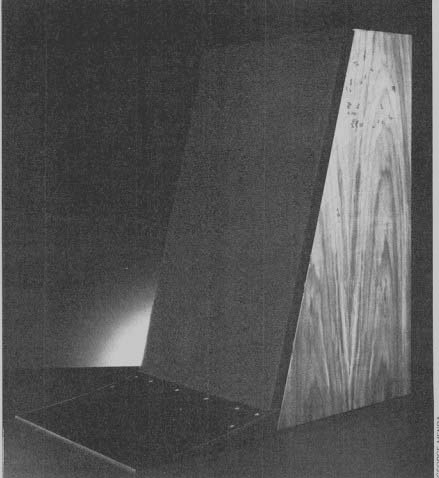
Snell Type 1 floor-standing loudspeaker system, in wood cabinet with walnut-veneer finish. Dimensions: 18 3/4 by 32 1/4 inches (front), 8 3/8 Inches deep at top; 16 3/8 Inches deep at base, plus 13 3/8 inches at base for convergence baffle. Price: $1,195 per pair. Warranty: "limited," five years parts and labor. Manufacturer: Snell Acoustics, Inc., 10 Prince Place, Newburyport, Mass. 01950.
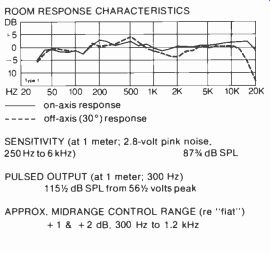
ROOM RESPONSE CHARACTERISTICS
DB +5 0 5 10 HZ 20 50 100 200 500 1K 2K 5K 10K 20K on axis response off-axis (30 °) response SENSITIVITY (at 1 meter; 2.8-volt pink noise, 250 Hz to 6 kHz) 87% dB SPL PULSED OUTPUT (at 1 meter; 300 Hz) 115% dB SPL from 56'' volts peak APPROX. MIDRANGE CONTROL RANGE (re "flat") + 1 8 +2 dB, 300 Hz to 1.2 kHz
SINCE THE EARLY SEVENTIES, designers have become increasingly aware of how room interactions affect the sound you hear from a loudspeaker. And many-including Peter Snell in his top speaker, the Type A-have followed Roy Allison's pioneering lead in taking steps to minimize the upper-bass response dip that can occur when reflections from room boundaries arrive at the listener's ear out of phase with the direct sound from the woofer. Removing this cancellation effect-the so-called Allison notch-eliminates the single most severe room-induced coloration.
It is not the only one, however, and what distinguishes Snell's new Type I speaker is how it tackles what is perhaps the most significant remaining inter action problem-the middle-and high-frequency response ripples caused by interference between the direct sound from the speaker and its reflections off the floor. Because the paths of the reflections are normally much longer than the path of the direct sound, the reflected sound takes longer to reach the listener's ear. If the delayed sound arrives in phase with the direct sound at a particular frequency, response at that frequency will be reinforced; if it arrives out of phase, the net output will be attenuated. The result is a series of peaks and dips in the frequency response. The pattern and severity of these irregularities vary ac cording to the height of the tweeter above the floor, the absorption characteristics of the flooring material, and so forth, but they are always present with a conventional loudspeaker.
Snell gets around this apparently in tractable difficulty by putting both of the Type l's drivers-woofer and tweeter-as close to the floor as possible, thereby making the paths of the direct and reflected sound nearly identical. The remaining gap is closed by the addition of a "convergence baffle"--a short ramp, hinged to the front of the speaker, that effectively extends the floor up to the drivers (covering, in fact, half of the 1-inch dome tweeter). Snell says the slope of the baffle is calculated to make the paths of the direct and reflected sound converge (hence the name), so that they remain perfectly in phase over the entire frequency range for smooth, ripple-free response.
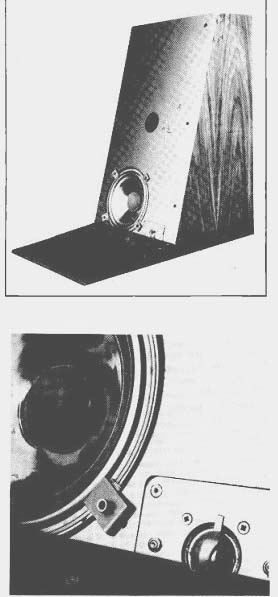
----- This close-up of the Type I's drivers shows how the
convergence baffle (the ramp coming up from the floor in front of the
speaker) covers the bottom half of the tweeter. Because the ramp's
hard surface is a sound reflector, its acoustic effect is analogous
to that of a mirror. If an optical mirror were placed here (that is,
horizontally bisecting the tweeter), it would reflect the top half
of the tweeter so that the reflected image would appear where the bottom
half actually is. Despite the reflection, therefore, you still would
see only one tweeter. Move the mirror to the floor plane, however,
and you'll see two tweeters-the real one and its reflection-with their
acoustic potential for mutual interference. Felt attached to the underside
of the convergence baffle absorbs the output from the bottom half of
the tweeter.----
The Type l's other particulars are more conventional. A metal strip in front of the tweeter affords some protection and acts as a diffuser, to improve high-frequency distribution. At 2 kHz, the tweeter crosses over to a 10-inch reflex-loaded woofer. The port is mounted about halfway up the enclosure's sloping front baffle, which tilts backward to optimize the convergence baffle's inter action with the drivers and to minimize standing waves within the box. The front baffle is completely covered by a removable foam grille, stiffened by fiberboard backing over all but those areas in front of the port or a driver. The speakers are sold in mirror-image pairs.
A recess at the rear of the enclosure holds sturdy five-way binding posts for amplifier connections, separate fuses for the woofer and tweeter, a large variable resistor intended mainly for factory tweaking of the tweeter level, and a three-position midrange contour switch.
The last makes possible subtle response touch-ups that compensate for the absorption characteristics of different floor coverings.
Diversified Science Laboratories' impedance measurements show a very flat curve. Aside from the bass resonance (where the impedance measures 22.5 ohms), it generally lies between 6 and 16 ohms with the contour switch at its nor mal position. Setting the contour for maximum boost lowers some values slightly. Based on these data and the speaker's moderately high sensitivity, we would expect most amps to have no difficulty driving a single pair, though some might balk at taking on two sets in parallel. In DSL's pulsed-power test, the Snell accepted the amp's full output without distress; in the 300-Hz continuous-power test, the woofer fuse performed its in tended function (perhaps a bit over zealously) by blowing at a little over 10 volts (the equivalent of 12 1/2 watts or more into 8 ohms, depending on how fast DSL raised the test level)-well be fore the speaker had a chance to get into trouble.
Distortion measurements are equally encouraging, becoming significant only at the very high level of 100 dB SPL, where total harmonic distortion reaches 5% at 250 Hz, 4 1/2% at 6.3 kHz, and 3 1/2% at 10 kHz. But these are isolated instances: Over most of the frequency range above 100 Hz, THD remains less than 1%. Naturally, performance improves at lower volumes. At sound pressure levels of 90 dB or less, total harmonic distortion averages less than 1/2% from 100 Hz to 10 kHz.
Most heartening of all is the speaker's exceptionally smooth on-axis frequency response, which remains within a ±2 1/2-dB range from 40 Hz to 20 kHz. Response is still good off axis, but the increasing directivity of the woofer as it approaches its relatively high cross over point creates a dip around 2 kHz, while the directivity of the tweeter above 10 kHz rolls off the top octave.
All speakers perform differently, depending on, in part, where they are placed with respect to room boundaries-wall, floors, and ceiling. Maximum bass output occurs when a speaker is placed in a corner; minimum low frequency output when it is put in the middle of a room, off the floor and away from the walls. DSL tested the Type I well away from side walls with its back against the rear wall. After some experimentation, we arrived at a similar position as the optimum in our listening room, with the speakers toed-in slightly, to put the listener at the sweet spot-on axis to both.
So positioned, the Snells sound very smooth, clean, and neutral, with deep, taut bass and sparkling highs. Some members of our listening panel did note a touch of thinness or brightness on some material, but this was virtually the only complaint. Although the reproduction is at its best on axis, the sound holds up very well off axis as well. Imaging is quite good: not as wide open as with some speakers, but with precise, stable placement of instruments and voices and a respectable sense of ambience and depth.
We experimented some with the midrange contour switch, whose sonic effect turns out to be fairly subtle. This impression is confirmed by DSL's measurements. We hear this in our listening room as a slight addition of body or warmth and find ourselves favoring the INCREASE-I position for most material.
Of course, the choice of setting depends heavily on room acoustics and personal taste.
The Snell Type I is a cunning implementation of a fascinating idea-and it's a good speaker, to boot. Indeed, were it less good, we might be inclined to look askance at the price, which is not small.
What it reflects, however, is unusual attention to detail in both design and construction. If what you're seeking is top notch sound in a handsome, well crafted, quirk-free package, the Snell Type I de serves a place on your auditioning list.
==========
An Avid Competitor
Avid 232 loudspeaker system, in wood cabinet with vinyl finish. Dimensions: 15 by 25 Inches (front), 10 Inches deep. Price: $275.
Warranty: "full," five years parts and labor. Manufacturer: Avid Corp., 10 Tripps Lane, East Providence, R.I. 02914.
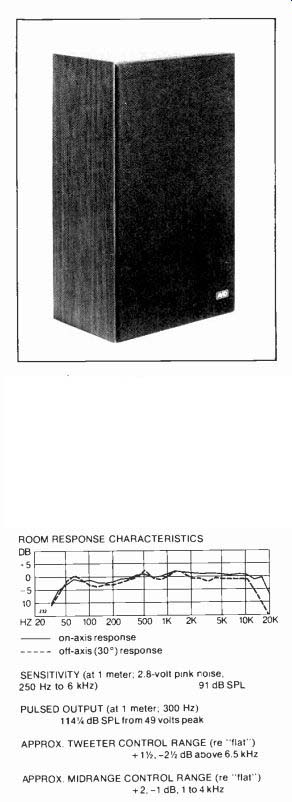
ROOM RESPONSE CHARACTERISTICS: on-axis response off-axis (30 °) response
SENSITIVITY (at 1 meter; 2.8-volt pink noise. 250 Hz to 6 kHz) 91 dB SPL PULSED OUTPUT (at 1 meter; 300 Hz) 114% dB SPL from 49 volts peak APPROX. TWEETER CONTROL RANGE (re "flat"); APPROX. MIDRANGE CONTROL RANGE (re "flat")
OUR LAST REPORT on an Avid product (March 1979) dealt with a first generation representative of the company's Minimum Diffraction Loudspeakers.
The Model 232 is a member of the second generation, which incorporates new drivers and a new constant-impedance crossover network while retaining the Optimum Dispersion Couplers that are the family's hallmark. Each midrange driver and tweeter has its own coupler, which flares out smoothly from the base of the driver. The speaker's solid grille panel has cutouts that fit snugly around the couplers so that their front faces are flush with that of the panel. In addition, the edges and corners of the grille panel are rounded, so that the sound radiating from the drivers encounters no abrupt discontinuities along its path. This de sign is said to reduce diffraction (i.e., deflection of sound waves as they pass a sharp boundary) and thereby to improve frequency response and imaging.
Removing the brown cloth-covered grille panel reveals the 232's three drivers-a 10-inch acoustic suspension woofer, a 2-inch dome midrange driver, and a I-inch dome tweeter-arranged in a vertical line. To the left of the mid- and high-frequency drivers is a panel that holds a protective fuse and three-position switched level controls for the mid range and tweeter. A pair of color-coded spring clips for amplifier connections is inset into the speaker's back panel.
Diversified Science Laboratories' measurements confirm Avid's claim that impedance is essentially constant over the audible band. Except for the usual rise at the woofer resonance (in this case, to 17.5 ohms at 45 Hz), the 232's impedance curve stays between 4.8 and 7.1 ohms from 20 Hz to 20 kHz regardless of the settings of the driver level controls.
With the controls centered in their nominally flat positions, the lowest impedance is 5.4 ohms at approximately 120 Hz. Consequently, a single pair of 232s should prove an easy load for any amplifier. With few exceptions, however, we would recommend against running two pairs in parallel from the same amp.
The Avid's sensitivity is high, as is its power-handling capacity. It accepted the maximum input in DSL's 300-Hz continuous-power test and in the pulsed-power test it handled peak inputs of 49 volts (equivalent to 24 3/4 dBW, or 300 watts, into 8 ohms) without stress, producing an output of 114 1/4 dB SPL.
Total harmonic distortion is' Unusually low at moderate levels (85 dB SPL), never rising above I% from 40 Hz to 10 kHz and staying below 1/2% over most of that range. As the output level goes up, so does the distortion, but at 90 dB SPL it still averages less than 1%, and at the very loud level of 100 dB SPL it hangs mainly in the 2-3% range.
After some experimentation, DSL elected to make its frequency-response measurements with the speaker raised ten inches off the floor and backed up against a wall. The resulting curves are remarkably smooth, especially at high frequencies. The on-axis response is ± 2 1/2 dB from 50 Hz to 17 kHz. Indeed, the only deviations from virtually ruler-flat response are the usual rolloffs at the extremes of the audible spectrum (where there :s rarely any significant amount of musical energy), a slight bulge centered about 1.2 kHz, and a mild dip below 500 Hz. Another very good sign is the close ness with which the off-axis curve tracks the on-axis one up to about 10 kHz.
Above that point the tweeter becomes increasingly directional.
Our experience in the listening room confirms what DSL's measurements imply-that the 232 is a very fine loudspeaker. With the speakers on stands with their backs against the rear wall and well away from side walls, the overriding impression is one of clarity and neutrality. Imaging is spacious, yet precise. Transients are faithfully reproduced, while vocal and instrumental textures come through distinctly and with out harshness. Some listeners did hear a slight lack of heft in the mid and upper bass. We were not able to eliminate this by repositioning the speakers, but it can be corrected by adjusting the midrange and tweeter level controls (which have a very gentle effect on the response) to their minimum positions. In a very dead room or one with strong low-end resonances, other settings might be better.
We don't know how much of what we like in the 232 results from special de sign features, such as the Optimum Dispersion Couplers, and how much is just the product of solid basic engineering. It doesn't really matter. A good speaker is a good speaker: how it got that way isn't important to the buyer. In our experience, the 232 is Avid's best speaker yet one that we can unhesitatingly commend to quality-conscious listeners.
============
Jensen's Best-Value Loudspeaker
Jensen System 500 loudspeaker system In wood cabinet with vinyl finish. Dimensions: 151/4 by 29 inches (front), 11% inches deep. Price: $290. Warranty: "full," five years parts and labor. Manufacturer: Jensen Sound Laboratories, 4136 North United Parkway, Schiller Park, Ill. 60176.
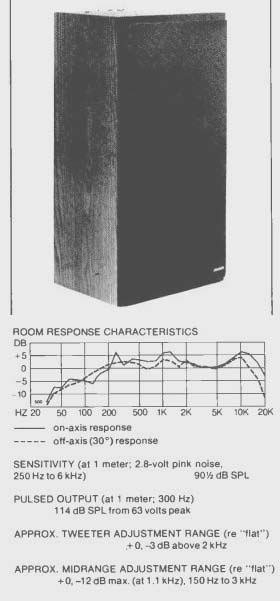
ROOM RESPONSE CHARACTERISTICS DB, on-axis response off-axis (30°) response 5K 10K 20K SENSITIVITY (at 1 meter; 2.8-volt pink noise, 250 Hz to 6 kHz) 90 1/2 dB
SPL PULSED OUTPUT (at 1 meter; 300 Hz) 114 dB SPL from 63 volts
PPROX. TWEETER ADJUSTMENT RANGE (re "flat") +0,-3 dB above 2 kHz
APPROX. MIDRANGE ADJUSTMENT RANGE (re "flat") +0,-12 dB max. (at 1.1 kHz), 150 Hz to 3 kHz
A LOGICAL CONTINUATION of the thrust begun in the top-of-the-line System B. Jensen's System 500 heads a lineup of four new medium-sized, floor-standing loudspeakers-the smallest of which could conceivably be called a bookshelf design. Like several other companies, Jensen has turned to computer analysis techniques in the design of its loud speakers-a move that probably contributed much to the overall quality of the System 500.
Like the System B (HF test report, January 1980), this smaller fellow is a multi-driver design with a 2-inch rear-firing tweeter for improved high-frequency distribution. The particulars, however, clearly differentiate it from its progenitor. An acoustic suspension design, the System 500 has three vertically aligned baffle-mounted drivers: a 12-inch woofer, 5-inch midrange, and 1-inch dome tweeter. (The System B is a four way ported design.) Rear-wave inter action within the enclosure is said to be minimized by the use of separately damped chambers for the midrange driver and tweeter. Mounted on the up per right corner of the baffle are continuously variable controls for midrange and treble; spring-loaded input connectors are located in a recess on the rear of the enclosure.
Impedance curves from Diversified Science Laboratories are fairly uniform for a system of this complexity: From a minimum of 7.5 ohms at 80 Hz, impedance rises gradually through the mid range to a maximum of 21 ohms, dips back to 8 ohms at 1.5 kHz, and then reaches another maximum of 12.4 ohms near 3 kHz. Considering the overall elevation of the curve and the speaker's relatively high sensitivity, you needn't worry about overtaxing even an amp of modest power with a pair of System 500s. They are no slouches, however, at handling high power inputs. Although they exceed distortion limits at an output of 105 1/4 dB SPL in the continuous-tone test, they accept the full output of DSL's amp in pulse tests: 63 volts peak, equivalent to 27 dBW (500 watts) into 8 ohms.
Though Jensen advises that the Sys tem 500s should be placed one to two feet out from the back wall in an average listening room (thereby allowing breathing space for the rear-firing tweeter while maintaining proximity to the wall for bass augmentation), DSL's calibration procedure accommodates two room placements-neither of which falls in Jensen's placement window. Because of the rear-firing tweeter, DSL made its frequency-response measurements with the rear of the speaker three feet from the wall (the other calibrated position is flush against the wall, but that placement would have killed the back tweeter's out put). A glance at the resulting curve ...
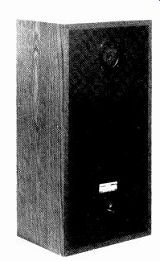
------- Back view of System 500, showing rear-firing tweeter.
... shows the consequences: a bass rolloff, starting at about 200 Hz, that likely would have been less severe had the speaker been closer to the wall. In fact, comments from most auditioners during our subjective evaluations of the System 500 focused first on the tightness and quality of the midbass when the speaker was placed correctly. The remainder of the frequency response curves show no marked anomalies. On-axis measurements depict fairly smooth response across the midrange, followed by a broad, shallow trough in the treble. The off-axis curve demonstrates the efficacy of the rear-firing tweeter in maintaining broad high-frequency distribution.
Across most of the treble region, on- and off-axis curves are virtual doppelgangers, becoming more like fraternal twins in the very-high-frequency range above 10 kHz.
Total harmonic distortion, measured at a moderate 85-dB sound pressure level, averages less than 1/2% over most of the test band, with second-order products predominating. At loud playing levels (100 dB SPL) distortion rises to an average of about P/2% over the same range, with an occasional excursion to more than 3%.
Finding the optimum position for the System 500s in the listening room was simple. Following Jensen's instructions, our first attempt placed the speakers about 16 inches from the back wall and resulted in the most pleasing overall balance. Treble was quickly assessed as being a shade too bright, however, and we turned to the high-frequency control to set things right, a task it accomplished quite handily. The lab data, in fact, attest to the usefulness of both the mid- and high-frequency attenuators.
The System 500's handling of a wide variety of musical material won unanimous plaudits. Midbass is remarkably uncolored, and deeper tones, though lacking some dramatic authority on super-low organ fundamentals, are tight and well articulated. Moving up in register, the reproduction of difficult percussive sounds, such as plucked strings and piano, demonstrates the speakers' agility, while woodwinds and brass emerge with clarity and zest. With their rear-firing tweeters, the 500s produce a predict ably wide and surprisingly deep stereo sound stage. Sound seems to emerge around and in front of the speakers.
Our delight with the 500s is best summed up by a staff member who commented that he could easily live with a pair without feeling that some as-yet-unheard but more expensive speaker would sound better-what we have come to call the audiophile insecurity syndrome.
Having already characterized the earlier System B as "the best speaker the company has ever made," we are tempted to dub its smaller sibling the best value ever from Jensen. And considering that Jensen has been making loudspeakers for some fifty years, that's praise, indeed.
=============
A Command Performance from General Sound
General Sound Micron III three-piece loudspeaker system (two satellite speakers and a floor-standing bass module), in wood enclosures. Dimensions: satellites, 7 by 10 inches (front), 7 inches deep; bass module, rods, 19 inches (front), 17 1/2 inches deep. Price: $550. Warranty: "limited," five years parts and labor. Manufacturer: General Sound, 2001 West Cheryl Drive, Phoenix, Ariz. 85021.
---------
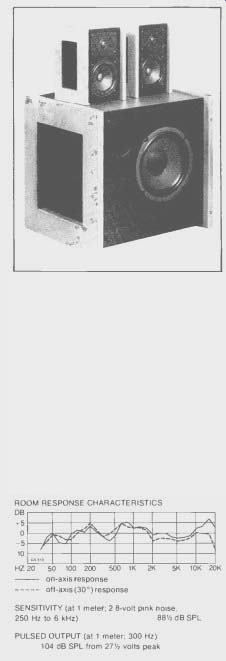
ROOM RESPONSE CHARACTERISTICS; on-axis response off-axis (30 °) response
SENSITIVITY (at 1 meter; 2.8-volt pink noise.
250 Hz to 6 kHz) 88 1/2 dB SPL
PULSED OUTPUT (at 1 meter: 300 Hz) 104 dB SPL from 27 1/2 volts peak------
THE BURGEONING INTEREST in three piece speaker systems (two small satellite speakers for middle and high frequencies plus a common "subwoofer" for the lows) surely rests on the format's flexibility and the accompanying prospect of true high fidelity, bass included, with minimal intrusion on the living room decor, even in spaces small enough to inhibit the use of regular, full-size speakers.
Among the companies that have moved to satisfy the demand for these systems is General Sound, which started its life as a manufacturer of mini-speakers. The GS-5 satellites in the company's Micron III system are not part of its regular mini-speaker line, however.
They are unusually small and, except for their blond wooden side frames, are finished in flat black. Most of those who saw them in our listening room commented on their striking appearance. of ten calling them handsome.
A removable grille cloth conceals a 5 1/4-inch acoustic suspension mid-woofer that crosses over a 2.4 kHz to a 1-inch soft-dome tweeter. Color-coded spring clips for making connections to the GS-10 bass module are recessed into the back panel. Cosmetically, the bass module is a squat, grown-up version of the satellites, with a wooden top so it can double as a table. Removing its grille reveals a 10-inch woofer and a large port. An easily accessible inset in the bottom of the cabinet sports a total of eight spring clips: four for the outputs from a stereo amplifier, and four for connections to the satellites. The internal 90-Hz passive cross over routes the bass to the subwoofer's voice coils. (It has two-one for each channel.) An overload-prevention sys tem cuts back the power delivered to the speakers if the drive level becomes too great.
This circuit came on only once in our test routine, during Diversified Science Laboratories' 300-Hz continuous-power trial, in which it limited the input to a level sufficient to produce a sound pressure level of 96 dB. In DSL's pulsed-power test, which more closely approximates music, the system accepted peak inputs of 27 1/2 volts (equivalent to 19 1/4 dBW, or 95 watts, into 8 ohms) for an output of 104 dB SPL. This is very good performance for a mini-speaker (the 300-Hz test frequency is too high to exercise the Micron III's bass module), and be cause there is a peak in the system's distortion curves at about 300 Hz, we suspect it would do better still at a slightly higher or lower frequency.
At a moderate level of 85 dB SPL, total harmonic distortion stays below 1/2% at most frequencies above 200 Hz; at the very high level of 100 dB SPL, it ranges principally between 1% and 4%.
At both levels, however, there are isolated excursions above the norm, especially in the vicinity of the 90-Hz cross over, where the satellite's small mid-woofer is under considerable stress.
The Micron III is moderately sensitive and has a smooth, low impedance curve that never rises above 10.6 ohms nor drops below 3.9 ohms. Over most of the audible frequency range, and through all of the musically active mid range, it is a 4-ohm system. Most amplifiers will find this a congenial load, but with all but a few amps we would recommend against operating a Micron III sys tem in parallel with other speakers.
DSL tested the system with a satellite placed above the bass module, both backed up against a wall. The resulting frequency-response plots lie within ±5 dB from 40 Hz to 14 kHz and within ±6 dB out to 20 kHz on axis. We tried locating the speakers in a number of positions in our listening room, finding in the process that the system doesn't seem particularly critical of placement. Most of our auditioning was done with the bass module halfway down a side wall, a few feet into the room, and with the satellites at ear level on stands placed well away from the side walls and several feet out from the rear wall. Although General Sound's instructions say that some installations will benefit from a reversal of satellite polarity relative to that of the bass module, we preferred the standard in-phase connection in our setup.
The Micron III generates a stable, spacious image that leans a little more to pinpoint positioning of voices and instruments than to openness or diffuse ness. Integration between the satellites and the bass module is very good, with no hint that the sound is coming from three boxes rather than the more usual two. Overall balance is essentially neutral, although some members of our listening panel noted a slightly heavy quality, particularly on voices. This is not an unpleasant coloration, however, and everyone who heard the system liked it, of ten commenting on its clarity and freedom from harshness.
In short, the Micron III is a thought fully designed system with healthy helpings of both ear and eye appeal. It is certainly very competitive in its price range and can take on many more expensive systems without fear of embarrassment.
(One of our listening panel prefers its sound to that of a highly respected monitor loudspeaker that sells for six times as much.) If you're shopping for a good satellite/subwoofer system at a good price, you owe yourself a listen to this one.
=================
In the Kossfire Between Acoustics and Decor
Koss 210 /Kossfire floor-standing loudspeaker system, in wood cabinet with vinyl finish. Dimensions: 15”, by 32 1/4 inches (front), 13” inches deep. Price: $275. Warranty: limited," five years parts and labor. Manufacturer: Koss Corp., 4129 N. Port Washington Ave., Milwaukee, Wis. 53212.

ROOM RESPONSE CHARACTERISTICS, on-axis response, off-axis(30°) response
SENSITIVITY (at 1 meter; 2.8-volt pink noise, 250 Hz to 6 kHz) 92 1/4 dB SPL
PULSED OUTPUT (at 1 meter; 300 Hz) 116 3/8 dB SPL from 51.8 volts peak
APPROX. TWEETER CONTROL RANGE (re "flat") , +2 dB above 1 kHz , -24V: dB max. at 12.5 kHz
APPROX. MIDRANGE CONTROL RANGE (re "flat") , +3 dB, 500 Hz to 1.6 kHz , -5 dB max. at 800 Hz
A CLEVER RESPONSE to a continuing consumer lament, the Koss 210 speaker sys tem is designed to deliver both satisfyingly deep bass and accurate high frequency response in rooms where matters of decor-not audiophile considerations-rule. Koss tackles the problem by assuming first that the non-audiophile, for whom this model was designed, generally likes speakers to be placed as inconspicuously as possible-usually flush against a wall. With that placement in mind, Koss posits further that most listening will take place away from a tweeter's horizontal axis, resulting in a less-than-pleasing high-frequency roll-off.
To remedy this, Koss uses two tweeters, mounted on opposing vertical walls of a rectangular, horn-shaped re cess in the baffle. The axes of these toed-in tweeters cross an inch or so in front of the drivers (hence the 210's Kossfire surname), providing a distribution of high frequencies across a wide listening area.
Midrange is handled by a 5-inch driver and bass by a 12-inch woofer operating in a ported enclosure. A built-in circuit breaker protects the system by opening when maximum drive levels (sensed as a function of voice-coil temperature) are exceeded; it automatically resets itself seven seconds later. Midrange and high-frequency level controls are mounted directly below the tweeter array, and connections are made with spring-loaded clips at the back of the enclosure.
Measurements made at Diversified Science Laboratories are characteristic of an able performer. In the continuous tone input test, the 210's circuit breaker opened at a drive level sufficient to pro duce a sound pressure level of 103 dB. In pulsed tests, the 210 withstood inputs of 51.8 volts peak (equivalent to 25 1/4 dBW, or 335 watts, into 8 ohms), producing a very loud peak sound pressure level of 116 1/4 dB. Efficiency is unusually high, and impedance never drops below 8.8 ohms across the audio band. In fact, considering its high efficiency and uniform, elevated impedance, the 210 seems a nearly ideal design if you plan to run two pairs simultaneously from the same transistor amp.
Frequency response is fairly uniform, holding to within ±3 dB from 48 Hz to 10 kHz. The off-axis curve, which follows the general shape of the on-axis curve in the treble, testifies to the effectiveness of the angled tweeter array in assuring broad high-frequency distribution. Total harmonic distortion at moderate listening levels (85 dB SPL) is quite low, averaging less than 1/2% across the band. It rises at higher volumes, of course, but only to about 1/2% at 90 dB SPL and 1% at 100 dB SPL.
Taking a lead from the Kossfires' evident design philosophy, we placed them against the back wall, about four feet in from the corners in our listening room. Happily, this first position resulted in a pleasing tonal balance.
Though the 210s are not altogether neutral reproducers, their coloration is hardly objectionable; in fact, some auditioners find the midrange warmth quite attractive. At moderate playing levels, the 210s handle most musical material with great style. Bass is satisfyingly deep; its hint of "bloom" may irritate the classicists, but it delights our pop aficionados. Walking across the listening plane and seating ourselves in a variety of off-axis positions, we tested the efficacy of the tweeter array and found that the frequency balance and stereo image hold up quite nicely over a broad listening arc. In fact, all auditioners singled out the sound stage created by the 210s as the speakers' most dramatic attribute gutsy, vivid, and three-dimensional.
At loud playing levels, listener reaction was a bit more mixed. The appealing warmth of the midbass can take on a rough, hard quality. Female vocals, one of the most revealing tests of a loud speaker, are reproduced nicely at moderate levels, but when the speaker is pushed too hard, upper registers become constricted. And extremely complex treble transients, such as the wild strumming of a flamenco guitar, lose definition and impact.
Considered in toto, however, the 210 is an admirable effort. Its design emphasizes the continuing effort of speaker manufacturers to factor room placement into the engineering of loudspeaker systems; that it brings such design considerations to the non-audiophile market makes it a welcome alternative. For the budget-conscious music lover the 210s represent real value in a crowded field.
=============
BML's Tower Tracer
BML Tracer 120-II floor-standing loudspeaker system, in wood cabinet with textured black finish and oiled walnut pedestal. Dimensions: 13 by 39 inches (front), 13 3/8 inches deep. Price: $370. Warranty: "limited," live years parts and labor. Manufacturer: BML Electronics, Inc., Acoustics Division, 5305 N. Ravenswood Ave., Chicago, Ill. 60640.
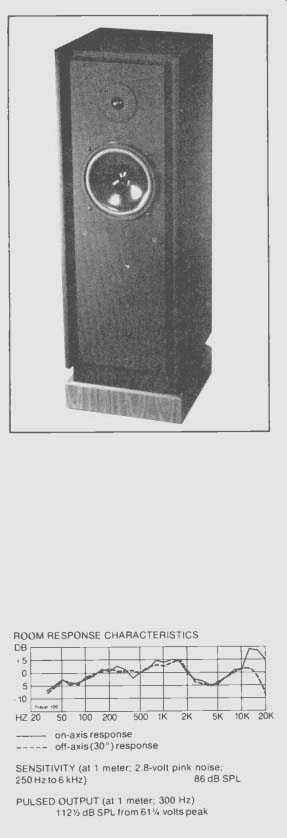
ROOM RESPONSE CHARACTERISTICS; on axis response oft-axis (30°) response; 5K 10K SENSITIVITY (at 1 meter; 2.8-volt pink noise; 250 Hz to 6 kHz) 86 dB SPL; PULSED OUTPUT (at 1 meter; 300 Hz) 112 1/2 dB SPL from 61% volts peak 20K
A SMALL COMPANY that has been around since 1973, BML Electronics has been re searching what speakers should do and gradually refining its own designs to approximate more nearly the emerging ideal. Having concluded that phase linearity is important for the accurate re production of music, the company now incorporates phase-compensation net works in the crossovers of all the speakers in its Tracer Reference Series. In deed, the name itself derives from BML's belief that the output of a loud speaker should be as close to a perfect "trace" of the input signal as possible.
One step below the top of the four-model line is the Tracer 120-ii, a two way system with an 8-inch woofer and a 1-inch dome tweeter. The woofer is loaded by a damped, resistive trans mission line, which terminates in a port on the back panel of the tall columnar enclosure. The drivers are protected by a removable black grille cloth. Amplifier connections are spring-loaded clips on the bottom of the enclosure, next to a protective fuse. Although this arrangement makes attaching the wires a little awkward (the speaker must be tipped on its side), it does do a good job of keeping them out of sight.
Diversified Science Laboratories' measurements show the Tracer 120-11 to be moderately sensitive, producing an 86-dB sound pressure level from a 2.8-volt input (equivalent to 0 dBW, or 1 watt, into 8 ohms). This, combined with the speaker's exceptionally smooth impedance curve, which never dips below 7 ohms at any frequency, suggests that al most any amp should find a single pair of Tracers an easy load to drive and that many will be able to handle a second pair in parallel without difficulty.
Power handling is also very good. In DSL's continuous-input test, the speaker accepted the maximum input of 28.3 volts (equivalent to 20 dBW, or 100 watts, into 8 ohms) without distress. And in the pulsed-power test, DSL's amplifier ran out of steam before the speaker did. Harmonic distortion is reasonably low (less than 1 1/2%) from 100 Hz to 10 kHz at a moderate playing level of 85 dB SPL, with the second harmonic predominating over the third. Total harmonic distortion remains less than 2 1/2% at 90 dB SPL, but at a very high sound pressure level of 100 dB, the Tracer begins to lose its composure, with distortion over 6% at 200 Hz.
BML recommends placing the Tracer between six inches and four feet from the rear wall, depending on personal preference-and the characteristics of the listening room. Our testing protocol offers just two calibrated testing positions; DSL chose that which puts the speaker four feet out from the back wall.
The on-axis plot shows a small dip at about 400 Hz, followed by a peak centered at about 1.3 kHz, then another, more severe trough in the crossover region around 4 kHz, and a final peak at about 13 kHz. Off axis, the response plot smooths out through the midrange and treble. The glitch at 400 Hz disappears altogether, while the directivity of the tweeter above 10 kHz tames the high end. The 1.3-kHz peak and the 4-kHz dip persist, however.
Although distinctive, the Tracer 120-II's sound is not easy to characterize. Careful placement seems especially critical with this model. Backed up within a foot of our listening room's rear wall, and several feet from the nearer side wall, the speaker is decidedly bass-heavy. Moving it three or four feet out cures that problem, but at the expense of giving many instruments-clarinet, trumpet, guitar, cello, and violin among them--an unnaturally bodiless sound.
We finally settled on a distance of about two feet from the rear wall, where the 120s sound their smoothest and most natural from the bass through the mid range.
In the treble, however, some instruments, such as cymbals, sound slightly tizzy and over-bright no matter what we do, while others-guitars and flutes, for example-are reproduced with a notice ably closed-in or woolly quality. Vocals come through beautifully, our sole com plaint being that there is occasionally a hint of thinness or a slight lack of open ness on female voices.
Lateral imaging is good, with stable, wander-free localization of voices and instruments. A few auditioners did comment, however, that the Tracer's sound stage isn't particularly un-constricted and three-dimensional. Though not, in the judgment of our listening panel, as neutral a transducer as some others, the Tracer 120-II is certainly a creditable design. Its combination of price, sound, and smart ebony styling seems sure to at tract a happy following.
-----------------------
Also see:
1982 Speaker Designs: Closer to Perfection? by Michael Riggs and Peter Dobbin-- A look at 100 new speakers; plus, how four speaker designers view their work.
New 1982 Equipment Preview, Part II: The Extras by Robert Long--Latest add-ons, noise reduction units, headphones, and ancillary devices